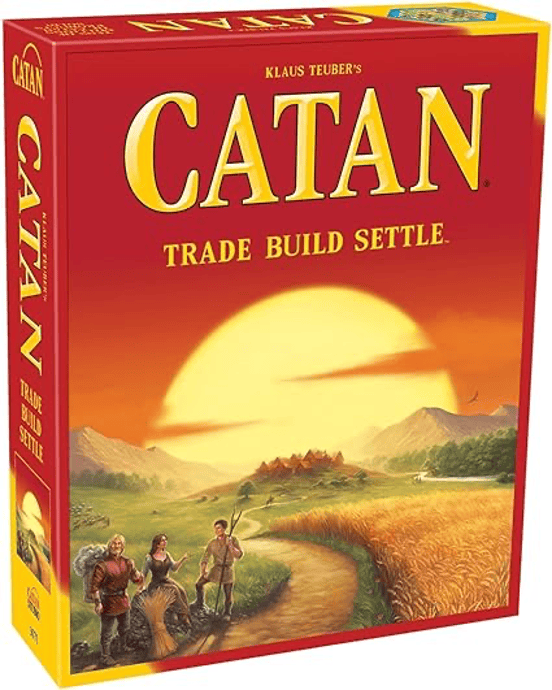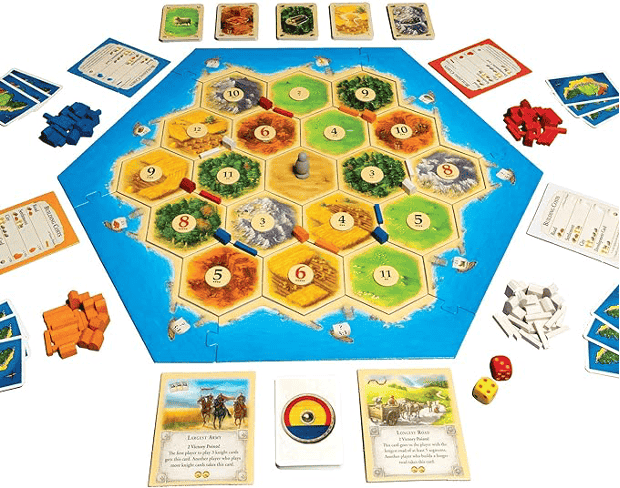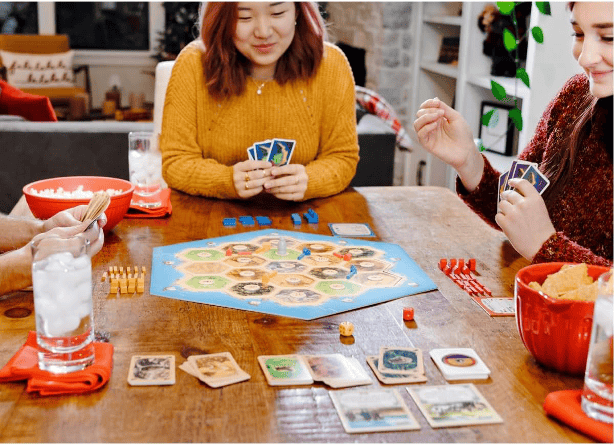
By: Catan Studio Players: 3-4 (up to 6 with expansions) Ages: 10+ Time: 60 mins +
Talk about a Modern Classic. This multi-award-winning, strategic co-op game is nearly thirty years old now and has seen success that very few board games achieve. Its unique and engaging gaming experience has made it a staple in the board gaming world, offering a perfect balance between luck and strategy that appeals to both experienced and new players alike. Even with the surge in popularity the medium has found over the last decade or two, very few board games have gained as much recognition and mainstream notoriety as Catan. In fact, by its 25th birthday in 2020, the game had sold over 32 million copies and been translated into 40 languages.
It’s so popular that tournaments are being held for the game worldwide all the time, the largest of which brought together over a thousand people! The modular board provides endless variety, contributing to Catan’s reputation as not just a game, but a must-have for any gamer’s library, making it a good game for nostalgia and an excellent gateway game into the hobby. Its enduring quality and appeal, combined with the joy of its great game play balance, ensure that Catan remains a great game in the board gaming community. For those of you who haven’t had the pleasure yet and are wondering what it’s all about, we’re going to be looking at the history of Catan board game, how to play catan board game, and discussing what we think of the game in general.
Humble Beginnings for Catan Board Game
Catan, or Settlers of Catan as it was previously known, was developed in 1995 in Germany by Klaus Teuber, who worked as a dental technician by day and designed games as a hobby. Teuber drew inspiration for the game from the idea of Viking settlers and even designed the fictional island of Catan after the likes of Norway and Iceland. Whilst some of his previous games were well received, “Die Siedler Von Catan” (as it was known in its home country) was his greatest achievement by far. So much so, that up until that point, it was the only board game that sold outside of Germany!
What’s It All About?

In Catan board game, players take on the role of settlers trying to establish settlements across the fictional titular island. Players will construct roads to connect their cities and try to claim as much of the board as possible. This will grant them a better chance of gaining more resources which in turn are used to build more settlements. If they are unable to generate the resources they need, there is a trade mechanic where players can swap resources to gain what they require. Players will earn victory points throughout the game for constructing establishments and the like. The first player to score 10 points is the winner.

How To Play
Before diving into the specifics of setup and player turns, it’s essential to understand the unique game play of Settlers of Catan. The balance of luck and strategy significantly impacts the player experience, making each game a new challenge. Whether you’re rolling the dice for resources or negotiating trades, the game play is engaging and offers a blend of strategic depth and social interaction.
If you’re looking to play Catan, you’re about to learn the essentials that have made this strategy game a cornerstone of tabletop gaming. From convincing friends to join in on the fun to mastering the art of negotiation and resource management, this guide will cover what you need to know to get started.
Many who have played Catan recall their first game with fondness. The strategic decisions, the player interactions, and the thrill of building their first settlement are experiences that make Catan not just a game, but a memorable journey.
Set up and Game Board
Catan is played on a board made up of 19 hexagonal tiles, each representing a different type of terrain. These tiles can be placed in any order, but the game provides a recommended set-up which they strongly suggest new players use. Each of these tiles will generate a specific resource: fields produce grain, forests produce lumber etc. but not every turn and not for every player.
At the start of the game, players will place 2 roads and 2 settlements on the game board. They will also receive resources (represented by cards) for any tiles around where their starting settlement is placed. If using the recommended tile set-up, the rules will show players where to place these components, as well as the number of tokens that go on top of the tiles. These numbers will indicate which tiles produce resources after the dice are rolled. Once all this is done, you’re ready to start playing.
Player Turns
Players can do the following three things on their turn:
v Roll for resource production
v Trade resources
v Build roads and settlements or buy development cards
A player starts their turn by rolling two dice, the results of which will indicate which hex tiles produce resources. Every player that has a settlement bordering this tile will receive one of that resource. If a player has several settlements bordering it they will receive one resource for each, and two of the resource if they have a city bordering the tile.
After this, players may perform one of two kinds of trades. Players can trade with each other, offering and counter-offering different resources they need to construct various things. Players can only trade with the active player, not with each other, but there is no obligation to offer or accept any trades. If players have too many of one resource, they can trade four of a kind (or three if bordering a harbor) for one resource of their choice.
Players finish their turn by building. Everything buildable has a resource cost, but if the player is able to pay this, they will be able to extend their reach via roads, settlements, and cities, improving the odds of their resource production at the same time. Roads must connect to each other or buildings and only one may be on a path at any given time. If a player can create a road of five segments or more they receive extra victory points via ‘The Longest Road’ card. Settlements must connect to roads and cannot be placed too close to each other. Cities are used to upgrade settlements and produce twice as many resources.
During this phase of their turn, players may also purchase development cards. These too have a resource cost to them and it’s random which card the player will receive but they all have their own perks. If a player accumulates enough Knight cards (3 or more) they receive the ‘Largest army’ card. Like The Longest Road, if a player can hang onto this, they will gain extra victory points.
Progress cards all have slightly different effects and have an effect on gameplay, like other players giving the active player some of their resources. There are also victory point cards which will (funnily enough) give players extra victory points. These should be kept hidden though and are used to help tip the scales and bring the player up to ten points to win the game.
The Robber
During all of this, there is a ‘Robber’ token on the board that may come into play at any time. The robber is activated if a player rolls a 7 on the dice. They first move to a nearby hex and then steal a random resource from any player owning a settlement or city adjacent to the tile the robber just moved to. Once the robber has moved, he will prevent any players with buildings adjacent to a tile that should be producing resources from receiving any. In addition to all this, if a 7 is rolled players will receive no resources, and anyone with 7 or more resource cards must send half back to the bank. It goes without saying, but 7 is anything but lucky in Catan!
Putting Together a Strategy
As you can see, Catan involves both strategic planning and luck. Thinking ahead about where your settlements and roads will be placed is important as placing them in the right location will help to generate a significant amount of resources. Equally, the dice can be cruel and it may take a while for you to receive the resources you need. It’s therefore important to polish off your silver tongue and try to use your negotiation techniques to convince players to give you the resources you need, which does get trickier as the game progresses. Not only that, but what you trade could result in you unknowingly giving your opponent the tools they need to take a big step closer to victory.
Expansions And Spin-Offs

Since its successful launch in the mid 90’s, Catan has spawned over 30 expansions to enhance or vary gameplay, and spin-offs with similar rules but a different theme. Initially designed for a maximum of 4 players, an extension was released soon after to accommodate up to 5 or 6. In 1997 the first true expansion was released: Seafarers of Catan, which added ships that players could use to cross sea hexes and explore an archipelago of islands. A year later in 1998, Cities and Knights was released. Some of the biggest additions to this expansion were introducing Knights that could be used to defend cities from invading barbarians, and allowing players to buy improvements for their cities that gave them various benefits.
Alongside the many expansions that have been released over the years, there have also been several variants of the game. Junior Catan was created with younger players in mind and came with a pirate theme, Star Trek Catan used the same rules as the original but took the game into space, and Game of Thrones Catan enlisted players in the Night Watch and tasked them with defending the wall whilst building settlements too. There are far too many to list here but needless to say if the base game starts to wear thin for any reason, there are plenty of options out there to help spice things up.
Final Verdict
Catan is an excellent game that’s accessible to practically everyone with it’s simple-to-follow rules. There’s a big emphasis on strategy with resource management and positioning, but the dice rolling and card drawing mechanics add an element of luck to gameplay. This essentially puts both hardcore and casual gamers on a somewhat even playing field which increases its appeal and doesn’t single anyone out. It’s a great gateway game for those entering into the hobby and provides an entertaining social experience. Definitely a must for anyone’s collection!
We earn a commission if you make a
purchase, at no additional cost to you.
Summary
v Simple rules
v Relatively short playtime
v Strategic depth
v Excellent social game
v Very accessible
If You Liked Catan…
If you like the sound of Catan, or have played it before and are after something a little different, here are some recommendations for other games you may like:
Carcassone
A tile drawing and placement game. Construct cities, roads, monasteries, and fields and score the most points by laying your followers down strategically.
Castles of Burgundy
Tile drafting and dice rolling dictate the flow of the game. Build the best kingdom possible whilst rearing livestock, running various industries, and trading with other players.
Ticket to Ride
A route-building game set in industrial era of America. Play cards and trains to create train lines, connecting cities across the United States, and scoring big by fulfilling secret route cards.
7 Wonders
A card development game spanning three ages. Players must use cards and resources to balance finances, population, and militaristic might to become victories, all while erecting wonders of the old world.
Small World
Fuse races and abilities together to create the strongest army to take over the small world. Place counters on a segmented map to control as much territory as possible. An ever-changing fantasy version of Risk.
Also Read: Kingdomino Board Game Review
FAQ
What is the best number of players for Catan?
Catan board game is designed for 3 to 4 players in its base game version, offering the most balanced and engaging experience. However, with the 5-6 player extension, the game can accommodate more players, though this may increase the game’s duration and complexity.
How long does a typical game of Catan last?
A typical game of Catan can last anywhere from 60 to 90 minutes, depending on the number of players and their familiarity with the game rules.
Can Catan be played with just 2 players?
While Catan is best enjoyed with 3 to 4 players, a 2-player variant can be played with adjustments to the rules. However, for a more tailored 2-player experience, it is recommended to look into “Catan: The Duel” which is designed specifically for two players.
Is Catan suitable for children?
Catan is suitable for ages 10 and up due to its strategic depth and complexity. For younger players, “Catan Junior” offers a more accessible and age-appropriate version of the game.
Where can I find expansions and versions of Catan?
Expansions and different versions of Catan are widely available at most board game retailers, both in physical stores and online. Official Catan websites and online marketplaces are also great sources for finding these additions.
How does Catan compare to other strategy board games?
Catan is known for its perfect blend of strategy and luck, accessibility to newcomers, and a strong emphasis on social interaction and negotiation. It’s often considered a gateway game into the world of modern board games, making it easier to transition to other strategy games with more complex mechanics.
